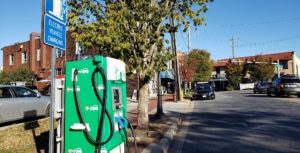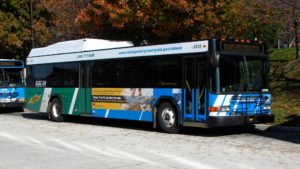When planning for transportation operations and investments, it is important to consider and mitigate any negative impacts on our climate and our environment, from the waters that are part of the Chesapeake Bay watershed to landcover and air. The TPB partners with COG and its members on issues of environmental mitigation and works to minimize greenhouse gasses emissions from the transportation sector and plan for the resiliency of the transportation system.
Climate change is real, largely caused by human activity, and is having a noticeable impact on the natural and built environment globally, including warming the atmosphere, ocean, and land. The changes are being driven by greenhouse gases (GHG) that are emitted from various activities, including the burning of fossil fuels. The TPB and COG have worked extensively with their member agencies and partners on approaches to mitigate climate change and prepare the region for impacts of climate change. Since 2010, the TPB has estimated the changes in on-road GHG emissions due to motor vehicles using the roads in its LRTP. By 2045, the latest analysis shows that annual GHG emissions are forecasted to be nearly 18 percent below 2005 emissions levels, or 11 percent below 2023 emissions levels. Greenhouse gas emissions per capita are expected to decrease by 24 percent between 2023 and 2045.
At its June 2022 meeting, the TPB adopted regional, voluntary, on-road transportation sector specific goals to reduce GHG emissions 50 percent below 2005 levels by 2030 and 80 percent below 2005 levels by 2050. The board also endorsed strategies to implement in support of this goal and additional strategies to further explore. This decision was informed in part by TPB and COG climate work, the findings of the TPB Climate Change Mitigation Study of 2021, TPB member considerations of the feasibility of each strategy, a TPB member survey, and board discussions. See a one-page overview of the goals and strategies here.
The TPB endorsed the COG resilience goal of “becoming a Climate Ready Region and making significant progress to be a Climate Resilient Region by 2030.” It also confirmed need to incorporate equity principles and expand education on climate change into its members’ actions to reach climate mitigation and resiliency goals. In 2021, the TPB conducted a study to support regional planning for resilience and implementation of resilience actions items documented in the COG 2030 Climate and Energy and Action Plan. Learn more about the studies below.
Learn more about the TPB planning activities for this climate and resiliency:
The TPB Climate Change Mitigation study of 2021 (2021) –The TPB undertook a scenario study, with consultant assistance, to assess ways to reduce greenhouse gas (GHG) emissions in the on-road transportation sector. The study assessed the types of transportation-related actions, and their levels of implementation, that would be needed to reduce GHG emissions to meet regional goals for 2030 and 2050. The region’s officials approved a new goal to reduce GHG emissions by 50 percent in 2030 relative to 2005 levels. Learn more.
The TPB Resiliency Study
The purpose of the TPB Resiliency Study is to advance regional planning for one of the federal Planning Factors, transportation resiliency and reliability, which is also one of TPB’s policy priorities.
- TPB Resiliency Study Memorandum: Inventory of TPB Member Recent Resiliency Planning Activities – The study team conducted research to document planning and capital-programming activities that the TPB member agencies and select partners are undertaking to prepare for the transportation system to be resilient in the face of natural disasters; These findings are summarized in the memorandum.
- TPB Resiliency Study Whitepaper – The study team developed a whitepaper that synthesizes the research findings. It documents regional vulnerabilities to natural hazards, discusses strategies for resilience, addresses equity in resiliency planning and the identifies potential MPO roles in future resilience planning efforts.
Transportation and Climate Initiative
The Transportation and Climate Initiative endorses the Transportation and Climate Initiative’s regional “cap and invest” policies and programs to further enable GHG emission reductions from transportation.
https://www.mwcog.org/uploads/pubdocuments/qF5eXVw20110617114503.pdf
https://www.mwcog.org/committees/multi-sector-working-group/
Environmental Consultation Environmental Inventory Mapping
- The National Capital Region Transportation Planning Board (TPB) is federally required to engage and consult with affected state and local environmental resource agencies regarding the development of the long-range transportation plan. This interactive map is used to inform about the relationship between the plan and regional-level environmental concerns by defining and inventorying environmental resources and data. The maps can serve as a tool to identify long-term regional mitigation strategies and high conservation priority or areas for potential restoration. These maps will be updated as part of the Visualize 2045 update. Map Detail | Metropolitan Washington Council of Governments (mwcog.org)
- Stormwater Management: COG staff assists members in meeting their stormwater management requirements through workshops, peer exchanges, and other ways of sharing information across the region.Stormwater Management – Water Resources | Metropolitan Washington Council of Governments (mwcog.org)


